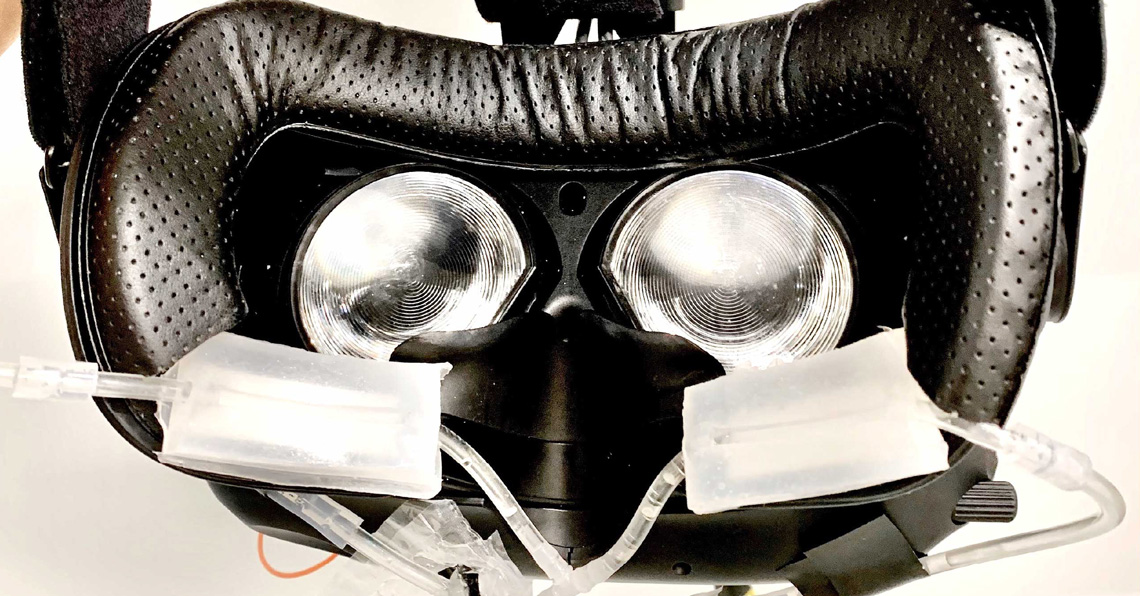Learning to work with chemicals as a haptic technology
Issue: XXIX.4 July - August 2022Page: 16
Digital Citation
Authors:
Jasmine Lu, Ziwei Liu, Jas Brooks, Pedro Lopes
In our recent paper "Chemical Haptics" [1], we explored how applying chemicals to the skin offers a new pathway to create haptic sensations such as warming, cooling, numbing, tingling, and stinging. Creating sensations using chemicals might seem entirely new, but it's inspired by knowledge that has existed for centuries in cuisine, drugstore products, and cosmetics. We set out to create a haptic device that controls the delivery of these chemicals to targeted locations on the skin.
Traditionally, haptic devices use actuators such as motors, heating elements, or electric stimulation, all of which attach to the surface of the skin [2]. Instead, chemicals need to be absorbed by the skin before triggering a feelable effect. In designing our device, we explored various delivery mechanisms, but we were most compelled by pumping liquids across the skin via open channels and circulating them in a closed loop. To implement this, we chose to use silicone patches that could be molded to have open channels through which liquids could flow, and that, when worn, feel like a second skin, as silicone is soft and stretchable.
We explored many ways to produce a tight seal between the silicone and the skin, including elastic bands, compression bandages, and Velcro. The latter two were used in our remote user studies, in which participants were able to attach the silicone patches, create a strong seal, and deliver chemicals to their skin using materials that were safe and easy to use at home.
In our final devices, we showcased two design strategies to inspire future chemical-haptics devices. In our cheek device, we demonstrated delivering liquids to hard-to-reach places, limited only by how far a tube could reach from a central unit (mounted on a virtual reality headset). The silicone patches are sealed to the skin using waterproof tape and rely on compression from the headset. Our forearm device is self-contained and wraps around the arm so snuggly that it creates a seal. We wanted to show how all electronic components could be embedded in the silicone itself to demonstrate chemical haptics in a wearable design that feels like an extension of the body.
Most importantly, we had the pleasure of exploring which chemicals can trigger skin sensations. To ensure the chemicals were safe for the skin, we sourced them via off-the-shelf products from local drugstores and supermarkets. We experimented with capsaicin (feels hot), methyl salicylate (feels strangely hot and cold), menthol (feels cold), lidocaine (feels numb), cinnamaldehyde (feels stingy), and sanshool (feels tingly).
Making with chemicals forced us to experiment with various form factors and methods. Many of our prototypes broke down and most experiments failed before we got them to feel right. Even our final designs can be significantly improved upon, such as via a more modular reservoir design or liquid metal wires. But ultimately, as a first foray into chemical haptics, we're excited by how our approach can broaden the ways in which we achieve touch sensations and are eager to see how our devices get remixed by others [3].
1. Lu, J., Liu, Z., Brooks, J., and Lopes, P. Chemical haptics: Rendering haptic sensations via topical stimulants. Proc. of ACM Symposium on User Interface Software and Technology. ACM, New York, 2021; https://doi.org/10.1145/3472749.3474747.
2. Culbertson, H., Schorr, S.B., and Okamura, A.M. Haptics: The present and future of artificial touch sensation. Annual Review of Control, Robotics, and Autonomous Systems (May 2018), 385–409; https://doi.org/10.1146/annurev-control-060117-105043
3. lab.plopes.org/#chemical-haptics (we made our device open source; you can download all its schematics and 3D printing files)
Jasmine Lu is a human-computer interaction researcher and a third-year computer science Ph.D. student at the University of Chicago conducting research with the Human Computer Integration Lab. Through her work, she explores how we might build the future of interactive technologies to be more sustainable and center ecological thinking. [email protected]
Ziwei Liu is a maker and tinker interested in human-computer interaction with a focus on wearable computing. She works on augmented reality headsets and experiments with technologies that bring independence and creativity to diverse audiences. [email protected]
Jas Brooks is a Ph.D. student at the University of Chicago's Human Computer Integration Lab. Their research investigates how chemical interfaces can intervene in everyday life, such as smelling and eating. These interfaces as uniquely situated for new I/O methods, assisting with smell disorders, and contributing to the arts. [email protected]
Pedro Lopes (https://lab.plopes.org) is an assistant professor in computer science at the University of Chicago, where he leads the Human Computer Integration Lab. His lab focuses on integrating computer interfaces with the human body—exploring the interface paradigm that supersedes wearable computing. [email protected]
Copyright held by authors
The Digital Library is published by the Association for Computing Machinery. Copyright © 2022 ACM, Inc.







